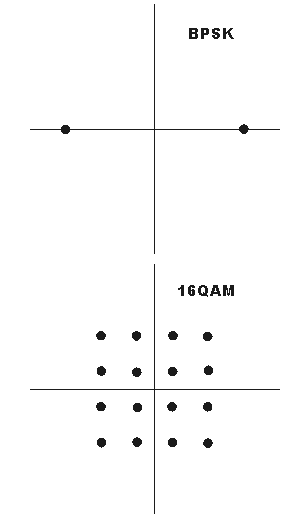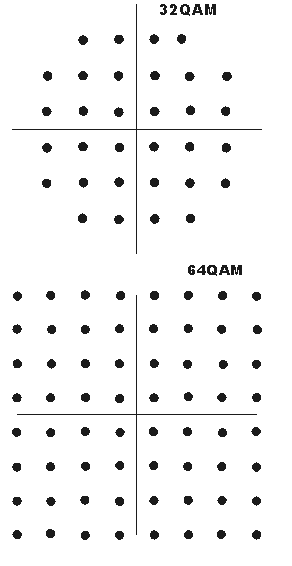Comparison between 8 QAM (8QAM), 16 QAM (16QAM), 32 QAM (32QAM), 64 QAM (64QAM), 128 QAM (128QAM), and 256 QAM (256QAM), all variations of Quadrature Amplitude Modulation
QAM, Quadrature amplitude modulation is widely used in many digital data radio communications and data communications applications. A variety of forms of QAM are available and some of the more common forms include 16 QAM, 32 QAM, 64 QAM, 128 QAM, and 256 QAM. Here the figures refer to the number of points on the constellation, i.e. the number of distinct states that can exist.
The various flavours of QAM may be used when data-rates beyond those offered by 8-PSK are required by a radio communications system. This is because QAM achieves a greater distance between adjacent points in the I-Q plane by distributing the points more evenly. And in this way the points on the constellation are more distinct and data errors are reduced. While it is possible to transmit more bits per symbol, if the energy of the constellation is to remain the same, the points on the constellation must be closer together and the transmission becomes more susceptible to noise. This results in a higher bit error rate than for the lower order QAM variants. In this way there is a balance between obtaining the higher data rates and maintaining an acceptable bit error rate for any radio communications system.
QAM applications
QAM is in many radio communications and data delivery applications. However some specific variants of QAM are used in some specific applications and standards.
For domestic broadcast applications for example, 64 QAM and 256 QAM are often used in digital cable television and cable modem applications. In the UK, 16 QAM and 64 QAM are currently used for digital terrestrial television using DVB - Digital Video Broadcasting. In the US, 64 QAM and 256 QAM are the mandated modulation schemes for digital cable as standardised by the SCTE in the standard ANSI/SCTE 07 2000.
In addition to this, variants of QAM are also used for many wireless and cellular technology applications.
Constellation diagrams for QAM
The constellation diagrams show the different positions for the states within different forms of QAM, quadrature amplitude modulation. As the order of the modulation increases, so does the number of points on the QAM constellation diagram.
The diagrams below show constellation diagrams for a variety of formats of modulation:


QAM bits per symbol
The advantage of using QAM is that it is a higher order form of modulation and as a result it is able to carry more bits of information per symbol. By selecting a higher order format of QAM, the data rate of a link can be increased.
The table below gives a summary of the bit rates of different forms of QAM and PSK.

QAM noise margin
While higher order modulation rates are able to offer much faster data rates and higher levels of spectral efficiency for the radio communications system, this comes at a price. The higher order modulation schemes are considerably less resilient to noise and interference.
As a result of this, many radio communications systems now use dynamic adaptive modulation techniques. They sense the channel conditions and adapt the modulation scheme to obtain the highest data rate for the given conditions. As signal to noise ratios decrease errors will increase along with re-sends of the data, thereby slowing throughput. By reverting to a lower order modulation scheme the link can be made more reliable with fewer data errors and re-sends.
